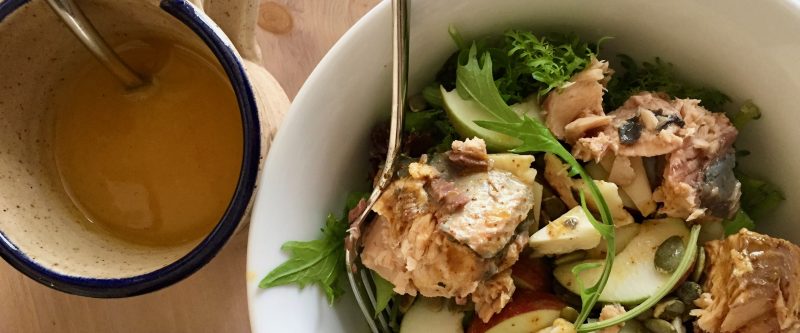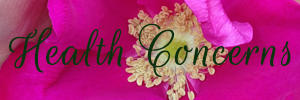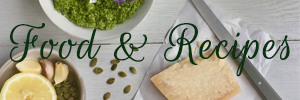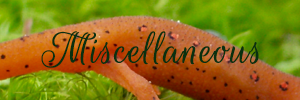Fortunately, pre-diabetes, insulin-resistance (the most common type of pre-diabetes), and type 2 diabetes are largely preventable and often can be managed or reversed with natural approaches including diet, exercise, and herbal remedies.
What Does Blood Sugar Imbalance Look and Feel Like?
Blood sugar dysregulation is incredibly common. The earlier you catch it, the easier it can be to manage naturally. Even before it’s reached a clinically diagnosable state, you can often see signs of imbalance. I often see blood sugar imbalance in my clients who have reproductive hormone wobbles as these two endocrine imbalances tend to feed into one another. In middle age, poor choices throughout our lives tend to accumulate and reach a critical state. Estrogen wobbles and decline in perimenopause make women more susceptible for blood sugar imbalance (which then drives reproductive problems including increased cancer risk, PCOS, and weight gain), while dwindling testosterone in men directly increases their risk of insulin resistance. That said, blood sugar imbalance can happen at any age. Thanks to poor diet, inactivity, microbiome health, and environmental toxin exposure, we’re seeing more and more young children now diagnosed with these “adult” conditions.
Signs & Long-Range Effects of Blood Sugar Instability
Note that these symptoms can be due to a wide range of factors and conditions, not only blood sugar dysregulation. If you suspect you have a blood sugar imbalance, seek professional guidance to for diagnosis and to rule out other potential conditions, such as hypothyroid disease, peri-menopause, or other endocrine imbalance.
- Weight gain, particularly abdominal and visceral (belly) fat
- Tired after you eat (especially after sugar or carbs)
- Cranky, moody, or brain fog with the blood sugar roller coaster, especially after high-carb food or when you get hungry (“hangry”)
- Excessive thirst, urination
- Excessive hunger, sugar cravings
- Insomnia, waking, restlessness, sweats, chills
- High triglycerides, VLDL, and LDL cholesterol, low HDL, heart disease
- Possible hypertension
- Gut dysbiosis
- Yeast infections
- UTIs and kidney issues
- Hormone dysregulation including…
- Estrogen dominance, endometriosis, PCOS, cysts, fibroids in women
- Andropause in men (low testosterone increases insulin resistance)
- Note that stress, hypothyroid disease, sleep apnea, and insomnia all increase the risk of developing diabetes and will need to be addressed directly
- Increased inflammation and pain
- Increased cancer risk (especially pancreatic)
- Increased risk of dementia and Alzheimer’s
- Poor circulation, damage to capillaries
- Nerve issues, neuropathy, tingling
- Poor wound healing, skin ulcers
- Worsening eye health, blindness
- Loss of limb(s)
Looking at Labs
Doctors, functional medicine practitioners, naturopathic doctors, or nutritionists will often order labs to assess your blood sugar status. (Only doctors and certain types of professionals can legally diagnose disease.) You can order your own labs online from a source like Ulta Labs, but you’re better off working with a practitioner who can help you interpret the results and determine the best approach for you – which may include diet, exercise, medications, or herbs. Here’s an overview of some of the types of labs that might be performed, and what ranges you can expect to see at different stages of disease.
| Test | Optimal (Functional) | Normal | Prediabetes/ Borderline | Diabetes/ High |
| Fasting Glucose | 75 – 89 | < 99 | 100 – 125 | 126+ |
| Glucose Tolerance | < 120 | < 139 | 140 – 199 | 200+ |
| A1C | 4.1 – 5.3% | ~ 5% | 5.7 – 6.4% | 6.5+% |
| Triglycerides | 60 – 100 | < 150 | 150 – 199 | 200+ |
| Cholesterol | 170 – 250 | < 200 | 200 – 239 | 240+ |
| LDL Cholesterol (”Bad”) |
< 100 | 100 – 130 | 130 – 159 | 160+ |
| HDL Cholesterol (“Good”) |
55 – 90 | > 60 | 60 – 40 | < 40 |
Sources: Thomas Easley Functional Blood Work Online Course, The Diabetes Council, ATP III
Why Does All of This Happen in the First Place?
Many factors are at play, but undoubtedly the two biggest players are diet (too much calories/carbs/sugar) and lack of exercise. We are hard-wired to love sugar because these energy-dense foods were not abundant in our early years as humans and foods that taste naturally sweet also have a very low potential for being poisonous. Unfortunately, modern life has surrounded us with an overabundance of sweet treats and an easy life with few physical demands.
Causes of Elevated Blood Sugar and Tendency to Type 2 Diabetes
- Too many calories
- Too many carbohydrates
- Too many high-glycemic foods (sugars break down more quickly)
- Being sedentary (even just half a day)
- Genetics, family history
- Gut bacteria/microbiome imbalance
- Stress/high cortisol
- Excessive alcohol consumption/alcoholism/family history of alcoholism
- Toxin exposure (BPA/plastic, fungicides, pesticides, and others)
- Viral/infection trigger?
Diet & Lifestyle Approaches
First, start off with a one-two punch. Diet and exercise habits can get you into blood sugar dysregulation, and they can also get you out. Various diets have been shown to be beneficial for reducing and regulating blood sugar and improving insulin sensitivity. These include…
- Mediterranean-like High Fiber Carbohydrate Diet, championed by health experts such as Dean Ornish. A strict, whole foods vegan diet also falls into this category – several studies support the concept that eating less meat and more plants and plant protein decreases diabetes. This diet focuses on slow-burn carbs in whole foods such as beans, nuts, seeds, and whole grains (not flour or sugar) alongside lots of vegetables.
- Low-Carb and Whole30/AIP/Paleo-style diets, first popularized by Robert Atkins and improved upon in recent years (less bacon and cheese, more grass-fed meat and vegetables). These usually emphasize protein and fat with very few carbohydrates and lots of vegetables. Some versions are more or less healthy than others. Note that eating a lot of protein (particularly animal protein) is hard on the kidneys and increases inflammation, and eating a lot of fat can aggravate the liver/gallbladder.
Personally, I take a moderate approach and combine some key concepts featured in both diets, though some individuals may find they do and feel better on one side of the spectrum. Some of the most helpful concepts:
Avoid Highly Processed and High-Glycemic Foods: Avoid or drastically limit packaged food, crackers, flour, sugar, pasta, bread, baked goods. Some whole foods are still ridiculously high on the glycemic index (which means they spike blood sugar quickly): dates, juice, tropical fruit, honey, maple syrup – keep these to a minimum.
Eat Protein: Whether plant or animal-based, protein increases satiety and helps reduce blood sugar spikes. Make sure to include some protein with every meal or snack. This often does best when combined with a small amount of complex/whole food carb and plenty of produce. Make sure to have a high-protein breakfast. Some examples:
- Apple + nut butter
- Beans + little bit of brown or wild rice + veggies
- Salmon/chicken + veggies + small serving of sweet potato/winter squash/whole grains
- Cashews + 1/2 to 1 cup grapes
- Carrot Sticks + hummus or nut butter
- Eggs + veggies/salsa + small serving of potato/sweet potato/rice/whole corn tortilla (even better if you add beans, too)
- Soup or stew: pasture-raised meat +/or beans + vegetables + root vegetables or winter squash
- Low-sugar smoothie: berries + yogurt/nut butter/almond milk + ground flax/chia seeds
- Salad: veggies + chicken/fish/chickpeas/nuts/seeds + cooked sweet potato/raw carrot/fruit + avocado or a drizzle of olive oil salad dressing
Sweeten with Sweet Herbs: Although it’s better to learn to enjoy food that’s less sweet, when you do need a little extra sweetness, turn to herbs that contain little sugar effect. My favorites include fennel (seeds and bulbs in cooking, fronds in seltzer), Korean licorice mint or anise hyssop (for cooking, drinks, tea), anise seed, cinnamon (tea, sweet and savory recipes), fenugreek (little maple flavor), and star anise. Of course, stevia can also be used in tiny amounts – it’s extremely sweet! – just a pinch here and there. I prefer the flavor of unrefined stevia leaves (which are green, not white, and can be grown as a tender perennial). I infuse it into vinegar for dips, dressings, and marinades (it resembles sweet pickles in flavor). In baking, just a little bit of the green powder can allow you to cut other sweeteners in half.
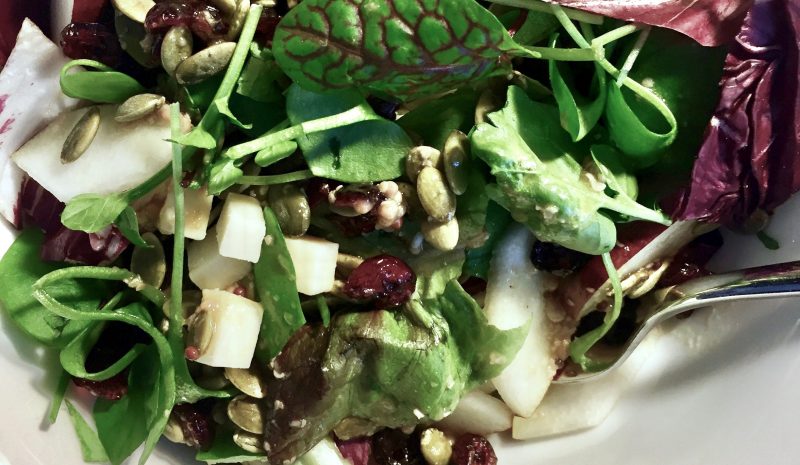
Listen to Your Body
There is quite a bit of room for flexibility here, so feel free to play around to find a diet that you are willing to follow for the long haul that makes you feel good and makes marked improvements in your health and blood sugar as time goes on. Are you hungry or satiated with your meal? Do you feel energized or tired? Are you gaining or losing weight? How’s your mood? You should begin to see improvements within a week, with greater improvement over the coming months and years.
Be Careful!
Adding herbs and making drastic changes in your diet and lifestyle can lower your blood sugar… which is the goal, but only to a point. Listen to your body and work with your doctor to monitor your blood sugar levels to ensure your blood sugar does not get too low – this can be dangerous and even life-threatening. If you have overt diabetes and especially if you take blood sugar regulating medications, you really need work with your doctor or a licensed naturopathic doctor – your medications will need to be adjusted.
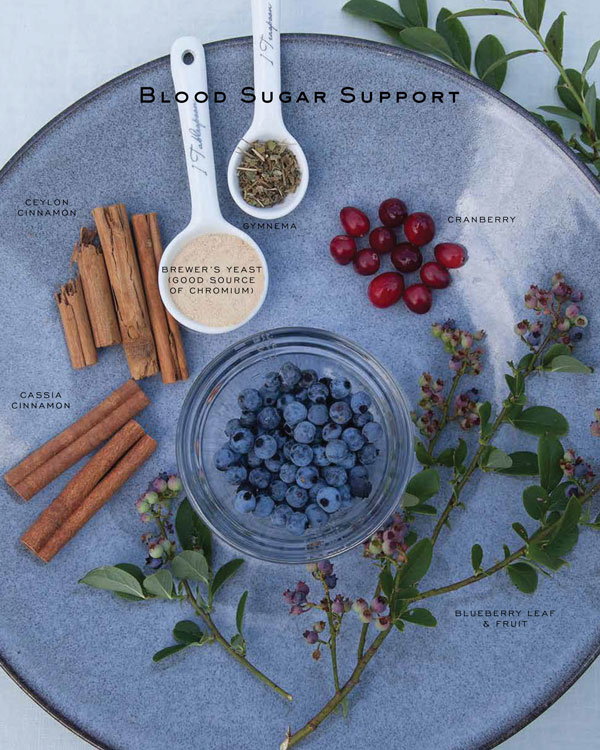
Blueberries, along with cranberries, brewer’s yeast, and cinnamon, and gymnema, can help address blood sugar troubles. Photo © Kimberly Sanders Peck, excerpted from Body into Balance, Storey Publishing
Herbal Approaches to Blood Sugar
Many different herbs can be used. Not all are appropriate for everyone, though. Blood sugar herbs should always be consumed alongside a meal, which is where they’ll be the most beneficial. If taken on an empty stomach or with a light snack, they could cause hypoglycemia! Tinctures, powders, and teas provide the easiest delivery because you can take them at the same time you’re eating. Pills take longer to break down and are more challenging to dose to ensure they’re available at the right stage of sugar breakdown – I generally avoid using them, but the typical recommendation is to take pills 20 minutes before you begin eating.
Again, please work with a practitioner before incorporating herbs if you’ve got advanced type 2 diabetes or are on medications.
(This blog does not cover type 1 diabetes, and people with type 1 diabetes are at even greater risk for dangerous hypoglycemia alongside these herbs. Some herbs listed here are entirely inappropriate in type 1 diabetes. Work with an experienced natural practitioner like an herbalist or naturopathic doctor and your prescribing doctor.)
Bitters (& Sours) ~ My Secret Weapon
In my practice when working with people with blood sugar dysregulation – especially those people who are in the early stages – one of my favorite herbal remedies is bitters. Bitter-tasting herbs (and foods) help lower blood sugar when consumed alongside a meal. The inclusion of bitter and sour “functional foods” help reduce blood sugar, regulate appetite, and provide other benefits for the body. Bitter- and sour-tasting foods include turmeric, artichoke buds and leaf, grapefruit, berberine-rich herbs like barberry, bitter salad greens (radicchio/endive/escarole/frisee/chicory, dandelion, arugula, mesclun mix), black coffee, dandelion root and/or leaf, chicory root, vinegar and pickled vegetables consumed with meals. They reduce the glycemic effect and help you feel more readily satisfied by your food. Over time, you will generally find that you crave less junk food and are drawn to more healthful foods, and that you’re less likely to overeat. This can be a great first step for someone who’s having a hard time sticking to a healthy diet. Just be adding bitters, you’ll not only support better blood sugar levels but you’ll usually voluntarily eat less junk as time goes on. In my practice, I usually add bitter herbs (artichoke leaf tincture is my go-to) to a customized tincture blend. Dandelion root tea is another option. Herbalists usually combine bitters with warming carminative herbs and spices such as cinnamon, cardamom, or fennel, which balances the flavor and energetics. Urban Moonshine sells some lovely bitters blends. A splash of bitters can be added to seltzer and sipped alongside a meal, too.
Blueberry
Various Vaccinium species have anti-diabetes reputation, including bilberry and cranberry. The American blueberry, specifically the lowbush species (V. angustifolium), is among the most recommended anti-diabetes herb amongst Quebec traditional practitioners (along with fenugreek, which, interestingly, is not at all native to the area though blueberries are). Although blueberry leaf has not been the subject of many studies, preliminary research backs up its long history of traditional use for diabetes. In the lab, an alcohol extract of blueberry leaf improved glucose transport into cells 15 to 25 percent in certain cells both in the presence of insulin and without it. Fruit extracts improved beta cell proliferation nearly threefold, and stem and leaf extracts reduced cell death in cells exposed to excessive amounts of glucose by 20 to 33 percent. These tests determined that various parts of the lowbush blueberry plant had insulin-like and anti-diabetic activities and also helped protect against glucose toxicity. Several recent animal studies have shown benefits in rodents with type 1 and 2 diabetes for blueberry/bilberry/cranberry fruits and/or leaves. Bilberry fruit extracts also ameliorated hyperglycemia while improving insulin sensitivity while other antioxidant- and pigment-rich berries have also shown some benefit in metabolic diseases in overweight women. In one of the few randomized clinical studies on blueberry leaf, 250 mg of blueberry leaf extract or a placebo was given to 42 volunteers with type 2 diabetes, three times daily 15 to 30 minutes before meals for four weeks. Blueberry leaf extract reduced fasting glucose by nearly 40 points (no significant change with placebo), CRP also dropped dramatically, and blood levels of ALT, AST, and GGT also improved. Polyphenolic antioxidant compounds in blueberry (which are also in white kidney beans, tamarind, lemon balm, rosemary, and green tea) are alpha-amalyase inhibitors, which is at least part of the reason why they help lower blood sugar. Blueberry fruits have a high degree of safety. Blueberry leaves are believed to be hard on the kidneys due to their tannin content and are traditionally not recommended in high doses, long term. That said, none of the research available to date suggests safety concerns in recommended doses of a cup of tea two or three times daily. Early season blueberry leaves generally contain fewer tannins. Nibble the leaves – good leaves for medicine have a nice blueberry tang to them.
Fenugreek
This culinary seed(Trigonella foenum-graecum) from India is a dynamic medicinal plant with various activities on the endocrine system in particular. The seeds contain steroidal saponin and phytoestrogenic compounds that likely play a role in various aspects of endocrine balance. Fenugreek has shown benefit women’s reproductive issues that have a glycemic component, including glycemic control and weight post-menopause or ovariectomy and a reduction of symptoms and insulin resistance in polycystic ovarian syndrome (PCOS). In one PCOS study, two 500 mg fenugreek extract capsules for just three months completely eliminated cysts in 36 percent of women studied; cyst size was reduced in 46 percent of the study participants; 71 percent returned to normal menstrual cycles; and 12 percent got pregnant! Fenugreek has been used since at least Greek and Roman times for blood sugar regulation. It seems to regulate the pancreas’ production of insulin. Several compounds are associated with its antidiabetic effect. The crude, whole seeds contain 50 percent mucilaginous fiber, which provides at least some of its benefits for blood sugar regulation, and approximately 80 percent of the total free amino acids are present as 4-hydroxyisoleucine, which directly stimulates insulin secretion. Trigonelline in fenugreek has been shown to be comparable to the diabetes drug glibenclamide and more effective than sitagliptine (Januvia). At least 10 placebo-controlled clinical trials with very similar results showed a reduction in fasting blood glucose and two-hour post-load glucose with a wide range of fenugreek doses. Fenugreek has been shown to improve fasting glucose in people with type 2 diabetes and metabolic syndrome without affecting people with normal blood sugar. Studies have also shown benefits for type 1 diabetes. Dosages vary widely, including relatively high doses of the crude seed powder (two 25 gram doses daily) and smaller doses (1 to 8 grams daily) of specially made extracts and capsules. In a study of people with diabetes and without, fenugreek encouraged favorable blood glucose curves, with a reduction of 42 percent. In one study of diabetes patients (40 percent of whom took various diabetes medications), 50 grams of crude fenugreek powder daily dropped cholesterol levels by 14 percent, with LDL and VLDL reduced and HDL slightly increased with the most significant changes occurring in the first eight weeks of treatment. Triglycerides decreased almost 20 percent. If this seems like an obscene amount of fenugreek to eat daily (if encapsulated, it would be about 100 pills), take comfort in another study using just one gram of hydroethanolic fenugreek extract. In this placebo-controlled diet, fenugreek was given to type 2 diabetics alongside diet and exercise for two months. The area under curve (AUC) of blood glucose and insulin were significantly lower compared to placebo with improved insulin secretion and sensitivity, cholesterol, and triglyceride levels. The most common side effects are digestive upset and gas, likely due to the high fiber content in the 50 gram crude seed powder studies. Fenugreek gives people maple-scented urine, which is harmless. When taken as a crude, high-mucilage form, it can delay absorption of other herbs or drugs taken at the same time and should be spaced apart by an hour or more. Fenugreek allergies have occurred, with chickpeas and peanuts (also legume family seeds) as a common cross-allergens. It should not be used in pregnancy even though it is commonly used as a nursing stimulant (increasing prolactin). Mouse and rat studies suggest it decreases T3 and increases T4 thyroid hormones.
Holy Basil/Tulsi
Holy basil (also called Sacred Basil and Tulsi) (Ocimum sanctum, syn. O. tenuiflorum) is easy to miss in a discussion about blood sugar because it’s known for so many other things, including stress support, adaptogenic action, and easing anxiety. It has a long history in India for many different conditions and general wellbeing with some clinical and a bit of preliminary research. The majority of the clinical studies on holy basil have actually been conducted on its cardiometabolic (cholesterol and blood sugar) effects. Particularly consider holy basil when cortisol is out of balance, when blood sugar issues and stress intertwine, and for stress-related sugar cravings. A review of 24 clincal studies – most on cardiometabolic factors – found that holy basil significantly reduced postprandial glucose and fasting glucose, improved BMI, cholesterol, triglycerides, reduced hemoglobin A1C, improved type 2 diabetes symptoms, reduced blood pressure, and reduced urine glucose levels. Dosages ranged from 250 mg to 3 grams taken before 2-3 meals per day. Generally very safe, but be cautious of hypoglycemia. It may affect the thyroid (based on animal studies), and I’ve encountered a few people that feel spacey or anxious with holy basil, but that’s not the norm.
Cinnamon
Compared to the other herbs discussed, cinnamon (Cinnamomum spp.) is the least appropriate for type 1 diabetes because it appears to work primarily on insulin sensitivity, making it more useful and safe in type 2 diabetes and insulin resistance. For this, several clinical studies have been conducted over the past 15 years with most having favorable blood sugar and insulin results results, although some studies have not shown significant benefits, and some reviewers have found a 50 percent risk for bias. Among the positive and well-designed studies, we have seen a drop in fasting glucose in type 2 diabetes by 10 to 30 percent, improved cell update of glucose, and reduced HbA1C, fasting blood glucose, triglycerides, and bad cholesterol. Various species of cinnamon appear to have benefit. The more compelling clinical evidence has been with C. cassia (the most researched, also called C. aromaticum), yet C. zeylanicum (also called C. verum) has safer levels of coumarins. The typical dose is two grams of powdered cinnamon daily, divided and taken with meals. As a fan of cinnamon tea, I was pleased to see one study on C. burmannii (often sold as cassia cinnamon, for example by Mountain Rose herbs) tea versus the powder. Researchers found that the tea had more antioxidant capacity and showed a stronger reduction in maximum glucose concentration with a slight reduction of post-meal glucose levels. This tea was made by soaking 60 grams of cinnamon sticks in one liter of water for 24 hours at room temperature, then simmered for 30 minutes before straining. If you choose to use cinnamon powder, as most studies have, “cinnamon slime” can be a bit off-putting – consider adding it to naturally slimy foods like applesauce or oatmeal. Though generally considered safe in standard medicinal doses, therapeutic doses of cinnamon are not recommended during pregnancy. Concerns have been raised around cinnamon’s relatively high coumarin content, which is carcinogenic and potentially blood thinning, though toxicity studies have only been done with isolated coumarin, not the whole herb. Reports of actual coumarin toxicity from people consuming cinnamon do not appear to exist in spite of widespread use throughout history for culinary and medicinal purposes as well as various animal and clinical studies on cinnamon. If you’re concerned, you can use Ceylon cinnamon, which has fewer coumarins than cassia, Indonesian, and other types of cinnamon. That said, excessive doses (far beyond the therapeutic range) of any type of cinnamon may be problematic, issues are more likely with the essential oil than crude herb, and cinnamon allergy and skin reactions are relatively common.
Gymnema
This Ayurvedic herb (Gymnema sylvestre) has a history of use for diabetes and its native name gurmar means “sugar destroyer.” Approximately 100 lab, animal, and human studies have been performed on gymnema, with most supporting its ability to promote blood sugar homeostasis and provide other health benefits. Randomized, placebo-controlled studies have shown it decreased fasting blood glucose, hemoglobin A1C (HgbA1c or HA1C) in type 2 and type 1 diabetics. In type 2, it increased insulin while it decreased insulin requirements in type 1, exactly as would be needed. It is possibly the best researched herb for the regeneration of beta cells, increasing the number of cells and stimulating their function. Gymnema also helps control triglyceride and blood lipid levels, decreases body weight, promotes healthy insulin production via the pancreas, and decreases glucose absorption in the intestines. Gymnema has some antibiotic and antimicrobial activity as well, which is interesting in light of the theory that diabetes is connected to immune function and infection. It even prevents dental cavities and is sold as a toothpaste in India. Although high doses may cause hypoglycemia, standard gymnema doses have been shown to generally be safe. Yet, even though various studies have shown liver-protective properties and toxicology studies had good outcomes, one study has linked gymnema to liver toxicity. This herb is usually taken in pill form, 400 to 800 mg of a standardized extract daily or two to four 500 mg capsules of crude herb. Use caution in type 1 diabetes and when combining it with diabetes medications. It will not eliminate the need for insulin in type 1 diabetes but may reduce the dose needed.
Recap ~ Potential Herbal Actions
Directly reduce blood sugar
- Blueberry Leaf*
- Vinegar*
- Bitters*
Increase insulin/sensitivity
- Bitters*
- Cinnamon (especially cassia)
- Chromium/brewer’s yeast (if deficient)
Help repair beta cells
- Gymnema*
- Blueberry Leaf*
Modulate insulin
- Fenugreek*
- Gymnema*
Insulin-like activity
- Blueberry Leaf*
- Fenugreek*
Protect from/repair damage
- Blue/cranberry*
- Hibiscus*
* May be useful in type 1 diabetes (cautiously and with medical supervision)
Learn More
Herbs and Blood Sugar Regulation Podcast on Plant Love Radio (formerly the Wellness Insider Network): In this fun, informative podcast with Lana Camiel, I discuss many of the concepts in this article including those I find the most useful.
Managing Type 2 Diabetes and Prediabetes Naturally (Herbal Academy Herbarium): this subscription-based service will give you access to my fully annotated article on this subject as well as all sorts of great advanced herbal articles, monographs, and intensive online mini courses
Body Into Balance: My best-selling, award-winning book has a whole chapter on blood sugar balance. This short excerpt provides some introductory information, details on blueberry, and a tasty blueberry tea recipe for blood sugar balance.
Blood Sugar Class from the Home Herbalist Series: For just $25 you can request the detailed class notes, slides, webinar, and audio for this online class. The full Home Herbalist Series is also available as an online course..
Intensive Endocrine System Support Webinar Series: For $100-150, take this four-part intensive online series geared towards professions with the American Herbalists Guild.
Clinical herbalist Maria Noël Groves sees clients and teaches classes at Wintergreen Botanicals Herbal Clinic & Education Center in Allenstown, New Hampshire.
The statements made on this blog have not been evaluated by the FDA and are not intended to diagnose, prescribe, recommend, or offer medical advice. Please see your health care practitioner for help regarding choices and to avoid herb-drug interactions.
Disclosure: Ulta Labs and Herbal Academy links are affiliate links.


